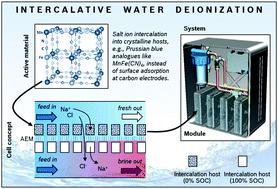当前位置:
X-MOL 学术
›
Energy Environ. Sci.
›
论文详情
Our official English website, www.x-mol.net, welcomes your
feedback! (Note: you will need to create a separate account there.)
Techno-economic analysis of capacitive and intercalative water deionization
Energy & Environmental Science ( IF 32.4 ) Pub Date : 2020-04-01 , DOI: 10.1039/d0ee00725k Michael Metzger 1, 2, 3, 4 , Münir M. Besli 1, 2, 3, 4 , Saravanan Kuppan 1, 2, 3, 4 , Sondra Hellstrom 1, 2, 3, 4 , Soo Kim 1, 2, 4, 5 , Elias Sebti 4, 6, 7, 8 , Chinmayee V. Subban 4, 6, 7, 8 , Jake Christensen 1, 2, 3, 4
Energy & Environmental Science ( IF 32.4 ) Pub Date : 2020-04-01 , DOI: 10.1039/d0ee00725k Michael Metzger 1, 2, 3, 4 , Münir M. Besli 1, 2, 3, 4 , Saravanan Kuppan 1, 2, 3, 4 , Sondra Hellstrom 1, 2, 3, 4 , Soo Kim 1, 2, 4, 5 , Elias Sebti 4, 6, 7, 8 , Chinmayee V. Subban 4, 6, 7, 8 , Jake Christensen 1, 2, 3, 4
Affiliation

|
We conduct a techno-economic analysis of electrochemical water deionization technologies. The objective of the analysis is to compare cost, volume, and energy consumption of membrane capacitive deionization (mCDI) to intercalative deionization techniques. Here, we first explore the concept of hybrid capacitive deionization (HCDI), i.e., a cation intercalation electrode paired with an activated carbon capacitive electrode. Then we explore in detail a novel device concept, fully intercalative water deionization (IDI), which relies entirely on the cation intercalation principle. The intercalation host materials in our study are Prussian blue analogs (PBAs), e.g., NiFe(CN)6 or CuFe(CN)6, that offer ∼3–5× higher gravimetric salt removal capacities than typical activated carbon. Our analysis shows that IDI should be superior to mCDI in module cost, volume, and energy efficiency, despite a more complex module architecture. Making careful assumptions on material costs, we provide a cost breakdown for mCDI, HCDI, and IDI modules and show that IDI is the only concept that is not dominated by ion exchange membrane costs. The environmental impact of electrochemical water deionization is illustrated by estimating the carbon footprint of currently installed reverse osmosis capacity in different world regions and comparing it to the respective carbon footprint of mCDI, HCDI, and IDI at similar capacity.
中文翻译:

电容式和插层式水去离子的技术经济分析
我们对电化学水去离子技术进行了技术经济分析。该分析的目的是将膜电容去离子(mCDI)与插入式去离子技术的成本,体积和能耗进行比较。在这里,我们首先探讨混合电容去离子(HCDI)的概念,即阳离子嵌入电极与活性炭电容电极配对。然后,我们将详细探讨一种完全基于阳离子嵌入原理的新型装置概念,即完全嵌入水去离子(IDI)。在我们的研究中,插入主体材料是普鲁士蓝类似物(PBA),例如NiFe(CN)6或CuFe(CN)6,比典型的活性炭提供约3-5倍的重量脱盐能力。我们的分析表明,尽管模块架构更为复杂,但IDI在模块成本,体积和能效方面均应优于mCDI。对材料成本进行仔细的假设,我们提供了mCDI,HCDI和IDI模块的成本明细,并表明IDI是唯一不受离子交换膜成本支配的概念。通过估算世界不同地区当前安装的反渗透容量的碳足迹,并将其与相似容量的mCDI,HCDI和IDI各自的碳足迹进行比较,可以说明电化学水去离子的环境影响。
更新日期:2020-04-01
中文翻译:

电容式和插层式水去离子的技术经济分析
我们对电化学水去离子技术进行了技术经济分析。该分析的目的是将膜电容去离子(mCDI)与插入式去离子技术的成本,体积和能耗进行比较。在这里,我们首先探讨混合电容去离子(HCDI)的概念,即阳离子嵌入电极与活性炭电容电极配对。然后,我们将详细探讨一种完全基于阳离子嵌入原理的新型装置概念,即完全嵌入水去离子(IDI)。在我们的研究中,插入主体材料是普鲁士蓝类似物(PBA),例如NiFe(CN)6或CuFe(CN)6,比典型的活性炭提供约3-5倍的重量脱盐能力。我们的分析表明,尽管模块架构更为复杂,但IDI在模块成本,体积和能效方面均应优于mCDI。对材料成本进行仔细的假设,我们提供了mCDI,HCDI和IDI模块的成本明细,并表明IDI是唯一不受离子交换膜成本支配的概念。通过估算世界不同地区当前安装的反渗透容量的碳足迹,并将其与相似容量的mCDI,HCDI和IDI各自的碳足迹进行比较,可以说明电化学水去离子的环境影响。











































 京公网安备 11010802027423号
京公网安备 11010802027423号